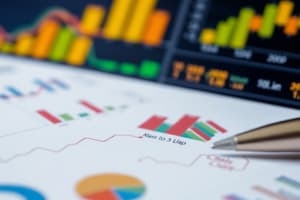Podcast
Questions and Answers
What is the primary purpose of business statistics?
What is the primary purpose of business statistics?
- To create marketing strategies
- To design operational procedures
- To analyze business data for informed decision-making (correct)
- To develop financial models
Which of the following is a measure of central tendency?
Which of the following is a measure of central tendency?
- Standard deviation
- Range
- Mean (correct)
- Variance
Inferential statistics primarily deals with which of the following?
Inferential statistics primarily deals with which of the following?
- Making predictions about populations (correct)
- Calculating averages
- Describing data characteristics
- Visualizing data trends
Which data collection method involves observing subjects without interference?
Which data collection method involves observing subjects without interference?
What is the purpose of a Chi-Square test?
What is the purpose of a Chi-Square test?
Which of the following is not a common method of data visualization?
Which of the following is not a common method of data visualization?
What does probability primarily study?
What does probability primarily study?
Which application is directly related to optimizing resources?
Which application is directly related to optimizing resources?
Flashcards are hidden until you start studying
Study Notes
Definition
- Business statistics involves the application of statistical tools and techniques to analyze business data and make informed decisions.
Key Concepts
-
Descriptive Statistics
- Summarizes and describes the features of a dataset.
- Includes measures such as:
- Mean (average)
- Median (middle value)
- Mode (most frequent value)
- Range (difference between highest and lowest values)
- Variance and Standard Deviation (measures of data dispersion)
-
Inferential Statistics
- Makes predictions or inferences about a population based on a sample.
- Involves hypothesis testing, confidence intervals, and regression analysis.
-
Probability
- The study of randomness and uncertainty.
- Fundamental for making predictions and decisions based on data.
- Key concepts include:
- Probability distributions (e.g., normal distribution, binomial distribution)
- The law of large numbers
- Central limit theorem
-
Data Collection Methods
- Surveys, experiments, observational studies.
- Importance of choosing a representative sample to ensure accurate results.
-
Statistical Techniques
- Correlation and Regression Analysis: Examines relationships between variables.
- ANOVA (Analysis of Variance): Compares means across multiple groups.
- Chi-Square Tests: Analyzes categorical data to assess how likely it is that any observed difference between groups arose by chance.
-
Data Visualization
- Graphical representation of data to identify trends and patterns.
- Common tools include:
- Histograms
- Bar charts
- Pie charts
- Scatter plots
-
Quality Control
- Uses statistical methods to monitor and control processes.
- Techniques include control charts and process capability analysis.
-
Applications in Business
- Market research: Analyzing consumer preferences and trends.
- Financial analysis: Risk assessment and investment analysis.
- Operations management: Optimizing resources and processes.
Importance
- Aids in decision-making by providing a framework for analyzing data.
- Helps businesses understand market dynamics and improve operational efficiency.
- Enables forecasting of future trends, improving strategic planning.
Definition
- Business statistics applies statistical techniques to analyze business data for informed decision-making.
Key Concepts
-
Descriptive Statistics
- Summarizes features of a dataset with measures such as:
- Mean: The average of all data points.
- Median: The middle value when data points are organized.
- Mode: The most frequently occurring value.
- Range: Difference between the highest and lowest values.
- Variance and Standard Deviation: Indicators of data dispersion, showing how much data varies from the mean.
- Summarizes features of a dataset with measures such as:
-
Inferential Statistics
- Uses sample data to make predictions about a larger population.
- Key techniques include hypothesis testing, confidence intervals, and regression analysis.
-
Probability
- Studies randomness and uncertainty, important for predictions based on data.
- Key elements include:
- Probability Distributions: Such as normal and binomial distributions.
- Law of Large Numbers: Suggests larger samples yield more accurate estimates.
- Central Limit Theorem: Indicates sampling distributions will approach normality as sample size increases.
-
Data Collection Methods
- Involves surveys, experiments, and observational studies.
- Importance of selecting a representative sample to ensure reliability of results.
-
Statistical Techniques
- Correlation and Regression Analysis: Investigates relationships between variables.
- ANOVA (Analysis of Variance): Compares means across multiple groups to determine significant differences.
- Chi-Square Tests: Analyzes categorical data to examine the likelihood of observed differences arising by chance.
-
Data Visualization
- Graphical tools for representing data, helping to identify trends and patterns.
- Common visualizations include:
- Histograms: Display frequency distributions.
- Bar Charts: Compare different categories.
- Pie Charts: Show proportions of a whole.
- Scatter Plots: Illustrate relationships between two variables.
-
Quality Control
- Employs statistical methods to maintain and improve processes.
- Techniques include control charts and process capability analysis, ensuring consistent output quality.
-
Applications in Business
- Market Research: Analyzes consumer preferences and market trends.
- Financial Analysis: Involves risk assessment and investment decision-making.
- Operations Management: Focuses on optimizing resource allocation and business processes.
Importance
- Business statistics enhances decision-making by providing a structured framework for data analysis.
- It facilitates an understanding of market forces and boosts operational efficiency.
- Enables businesses to forecast trends, supporting improved strategic planning.
Studying That Suits You
Use AI to generate personalized quizzes and flashcards to suit your learning preferences.




